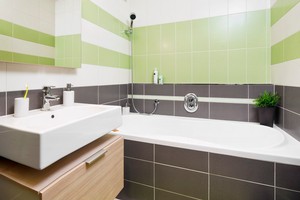Ceramic tiles applied to existing tiling
 In reconstructions, we encounter the issue of applying ceramics on top of existing tiles. For ceramic tiles, the task is often to ensure its adhesion to the base and to level any uneven spots. Therefore, a contact bridge must be installed to ensure the new tiles adhere correctly and interact with the base. The following materials will ensure a long service life of the new tiles and allow them to serve their aesthetic purpose.
In reconstructions, we encounter the issue of applying ceramics on top of existing tiles. For ceramic tiles, the task is often to ensure its adhesion to the base and to level any uneven spots. Therefore, a contact bridge must be installed to ensure the new tiles adhere correctly and interact with the base. The following materials will ensure a long service life of the new tiles and allow them to serve their aesthetic purpose.
Type of structure
- CP 203 or PE 204 contact bridge
- LE 30 or LE 20 self-levelling screed for floors that need to be levelled
- AD 520, AD 530, AD 550 adhesive
- Ceramic tiles
- GF DRY or GF BIO flexible jointing material
- SI silicone sealant + PES polyethyle separator
Work procedure – detailed description
Preparation: The base must exhibit adequate strength and consistency before laying. If the existing tiles exhibit visible defects (they do not stick to the wall, bulge when knocked, existing joints crumbling, etc.), the incoherent and damaged surface must be removed. A contact bridge is applied to the existing tiles and lining cleaned of any impurities and grease (CL 810), using CP 203 or PE 204 (walls and floors). The base flatness deviation must not exceed 2 mm per 2 m of the bar. On walls, flatness must be ensured using LE 21 self-levelling screed; on floors, it must be achieved using LE 20 or LE 30 self-levelling material. Any shortcomings in wall tiles may be locally redressed by applying a layer of the adhesive used.
Insulation – sealing all water-loaded rooms: See the bathroom system solutions.
Installation of ceramic wall and floor files: AD 520, AD 530 and AD 550 modified flexible adhesive sealants must be used for wall and floor tile installations. Between 3 to 4.5 kg/m2 of adhesive will be needed.
Ceramic shell jointing: For jointing, we use CG2 WA grade GF BIO or GF DRY flexible material. Thanks to special additives, use of these jointing materials increase the water repellent qualities of the system; GF BIO moreover offers protection against mould and efflorescence. This markedly increases the sanitary properties of the entire surface! Approx. 0.3 to 0.8 kg/m2 is needed, depending on the format size of the tiles. For larger areas (corridors, halls, etc.), once the adhesive has fully cured, CG2 WA S1 grade GF S cement adhesive, supplied in 3 colours, is used for full-area jointing. Approx. 0.4-0.8 kg/m2 is needed.
Sealing flexible joints and passageways with permanently elastic sealant: Permanently elastic SI sealant must be used to allow expansion movement within the joint. The colour spectrum covers all colours available in the GF series. If SI material is applied, it is recommended that PES polyethylene separators be used. They will prevent undesired adhesion to the bottom of the joint and define the exact shape of the silicone filler. The spreading rate of the 310 ml cartridge is approx. 6-12 bm, depending on the size of the joint.
Cleaning: Once residual cement is removed, use the CL 802 cleaning agent. Once the surface is thoroughly cleaned, we recommend that full-surface priming be applied with CL 809.
Maintenance: For regular maintenance, use the CL 803 cleaning agent combined with CL 802 (scale) and CL 810 (grease).







